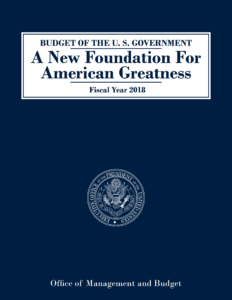First Look: President Trump’s FY18 Budget Request is Rough for Science
 Today President Trump released a more detailed budget request for FY 2018, a follow up to the “skinny” budget released in March, and science agencies fare pretty poorly (as do a lot of other government programs), though U.S. efforts to develop “exascale” computing capabilities were prioritized. Here are some quick details:
Today President Trump released a more detailed budget request for FY 2018, a follow up to the “skinny” budget released in March, and science agencies fare pretty poorly (as do a lot of other government programs), though U.S. efforts to develop “exascale” computing capabilities were prioritized. Here are some quick details:
- The National Science Foundation would see a cut of $841 million overall vs. FY 17, to $6.65 billion — a cut of 11.2 percent. NSF’s Computing and Information Science and Engineering Directorate would see a decrease of 10.3 percent under the plan. Within CISE, the priority is core research and research in national priority areas.
- DOE’s Office of Science would see a $862 million cut from FY16 levels to $4.43 billion — a cut of 16 percent. However, the agency’s efforts to deploy an Exascale-class supercomputer were bolstered by a $101 million increase (16 percent) to the Advanced Scientific Computing Research’s (ASCR) Exascale Computing Program (ECP). With the increase, ECP is expected to begin site-prep and initial engineering for the deployment of two different exascale architecture machines, the first in 2021, and the second in 2022. Research funding in Applied Mathematics and Computer Science accounts has been transferred to the ECP program, with no change in scope (according to the administration).
- The National Institutes of Health would see a cut of 20 percent, or $6.2 billion less than FY 16.
- National Institute for Standards and Technology research and development cut 15 percent.
- NASA R&D cut 23 percent.
- Defense basic research (6.1) would see a 6 percent increase; Defense applied research (6.2) would see a 3 percent increase.
- Department of Homeland Security S&T cut 27 percent.
- EPA S&T cut 47 percent.
I can’t recall a time in my 15+ years of working science policy that science agencies across the board have endured these levels of proposed cuts. You’d have to look back to the early years of the Reagan administration to find similar levels of reductions.
The good news is that it appears many in the leadership in Congress are ready to look past much of this request. While applauding the idea of a budget that “balances,” most of the key players have indicated that much of the rest is problematic and that many of the proposals will have a hard time finding fans in either chamber.
That noted, though the President’s budget is just the first step in the annual appropriations process and Congress will have much to say about it, we are undoubtedly in a more difficult position than if the President’s request had been more favorable to investments in research. If you wanted a blueprint for how the U.S. could cede its global S&T leadership, this budget would be a good start at one. We’ve got our work cut out helping the science community make its case for the importance of these investments.
We’ll have more details as they come available today and in the days to come….








